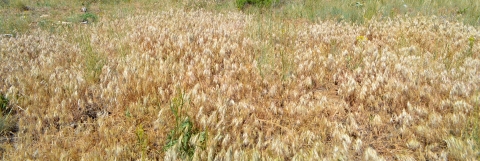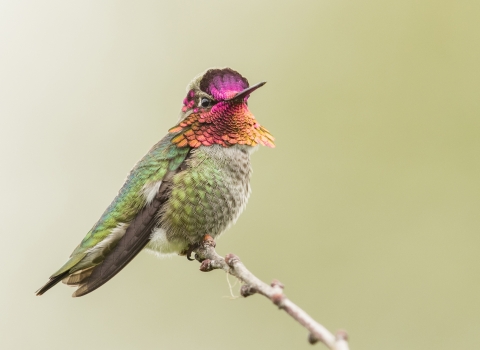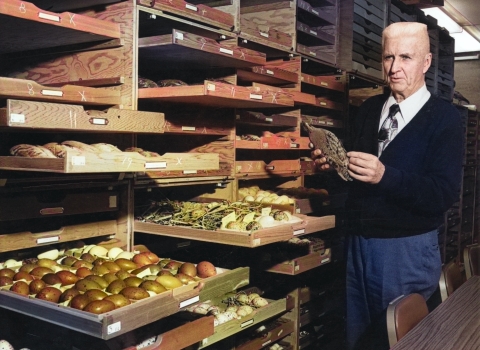EDITOR'S NOTE: 2023 marks the golden anniversary of the ESA, a law that has been a powerful catalyst for conservation of America’s most treasured fish, wildlife, plants and their habitats for five decades. People power the mission of the U.S. Fish and Wildlife Service. Here in the Pacific Region, Tribal, federal and state partners, local supporters, and our dedicated staff are the driving force behind the successes we share and the strength ensuring we can continue to face the challenges ahead. Throughout this year-long celebration, we invite you to celebrate this milestone with us as we reflect on past successes, assess current challenges, and envision an equally bright future for the next 50 years and beyond.
This story was originally published on January 2, 2018.
It’s just a few degrees above freezing in eastern Washington. A thin layer of snow and ice covers the sagebrush sagebrush
The western United States’ sagebrush country encompasses over 175 million acres of public and private lands. The sagebrush landscape provides many benefits to our rural economies and communities, and it serves as crucial habitat for a diversity of wildlife, including the iconic greater sage-grouse and over 350 other species.
Learn more about sagebrush steppe. There are more than 350 species that depend on the sagebrush ecosystem for habitat, and most of them are hunkered down for the winter, waiting for the big spring thaw.
The sagebrush steppe is large and complex, composed of high mountain deserts, wet meadows, and sagebrush shrublands. The climate is stark and arid, with freezing winters and blazing summers. The sagebrush ecosystem is also one of the most imperiled in the United States. At one time, it covered more than 240,000 square miles of the western United States, but today has shrunk to almost half. There are many reasons for the loss of habitat, including human development, wildfires, and conversion to cropland.
One of the major culprits? Invasive species.
“The problem of exotic annuals is so severe. We’ve already lost a lot of important habitat to it,” said Matt Germino, ecologist with the United States Geological Survey (USGS). “Wildfires fueled by exotic annual grasses are a huge problem for everyone. Managers of all walks and perspectives are in need of tools to reduce exotic annuals and encourage the growth of desirable perennial plants.”
Cheatgrass. Medusahead. Redbrome. These hardy, water-sucking plants dry out landscapes, out-compete native grasses for nutrients, and prolifically produce seeds. Just a few plants are capable of spreading enough seeds to take over an area with native grasses, with disastrous results for wildlife, ranchers, recreators, and the western landscape.
“There’s no winners when it comes to exotic annual grass invasion,” Germino said. “Everyone loses something. It has affected so many millions of acres, and there are millions of acres at risk. Exotic annual grasses are at the heart of our country’s largest challenge and effort to maintain healthy, sustainable rangelands.”
Managers have tried various tactics to beat back these invasive species invasive species
An invasive species is any plant or animal that has spread or been introduced into a new area where they are, or could, cause harm to the environment, economy, or human, animal, or plant health. Their unwelcome presence can destroy ecosystems and cost millions of dollars.
Learn more about invasive species , the most successful of which is herbicide treatment. But herbicides can’t be sprayed everywhere, all the time. Invasives are so prolific, and the problem is so extensive, that herbicides alone aren’t enough to manage exotic grasses.
A tiny solution to a big problem?
In 1989, Dr. Ann Kennedy from the USDA-Agricultural Research Service was the first to discover the potential for using soil microbes to inhibit the growth of a plant’s root system. She and her colleagues isolated an organism known as D7, and field-tested it for years to see how it would perform in various climates and conditions. The results were promising enough that researchers from other federal and state agencies, as well as conservation organizations and private businesses, began exploring the potential for bacteria and biocontrols.
There are currently three strains of bacteria that researchers are focusing on: D7, ACK55, and MB906. All of these bacteria assail cheatgrass by producing and delivering weed-suppressive compounds to the weed root. It’s a sneak attack, an attempt to go after the plant’s root system to inhibit growth and spread. If successful, the bacteria would give native grasses a chance at regaining a toehold on the landscape.
Researchers are hoping that a toehold is all native grasses would need.
“Ecologically, bacteria is a good fit in that it inhibits root growth,” Fish and Wildlife Service biologist Mike Gregg said. “These plants put all of their energy into root growth. The smaller the plants, the fewer the seeds. It won’t destroy the invasives, but it could put the native plants on an equal playing field.”
Researchers discovered that the bacterium need precise conditions to survive. They need to be applied in the fall, with a temperature of less than 50 degrees Farenheit, with moisture (from rain) in the soil. They need to be successful enough to establish over winter to inhibit cheatgrass in the spring. The soil can’t have too much clay or high amounts of organic matter. Finally, the cheatgrass itself needs to be just starting to germinate or the bacteria won’t work.
Here’s the deal: we’re talking about bacteria,” Germino said. “Bacteria needs moisture, warm enough temperatures, and the right kind of organic matter to grow in the soil. The desert soils that are most impacted by exotic grasses—and by extension, wildfires—are also the areas that have the highest temperature, least moisture, and least organic matter. Bacteria might be able to help, but will it help in the right places? Will it help at the right times? Will it be effective enough to justify the costs?”
Trials so far have produced mixed results. It can take three or more years for the bacteria to produce results, so Germino says we need to be patient. He believes that it is unlikely bacteria will be an effective control for cheatgrass and other invasives. It is more likely that it will work under certain conditions, in certain places.
“People are getting excited over potential silver bullet technology, but the reality is that there’s no silver bullet solution here,” Germino said. “There are multiple causes for why our landscapes are getting invaded. We’ll need multiple solutions.”
In the meantime, researchers, ranchers, and land managers are trying everything they can to stop the spread of cheatgrass and other invasives. Landowners have been protecting and planting native grasses in an effort to stabilize the soil and provide forage for livestock and wildlife. Perennial bunchgrasses—which are literally bunches of grass that grow in shrub-steppe—are particularly important where there is a lot of fire activity.
“If this works, we can start treating areas that are at-risk,” Gregg said. “Those areas that are just a fire-or-two away from being taken over by invasives. We can give native grasses a chance to regain dominance.”
The goal? A healthy sage steppe landscape that is resilient against weed invasion, wildfires, and other disturbances. Bacteria may be only a small part of a complex solution, but it may be a critical part of sagebrush conservation in the years to come.





